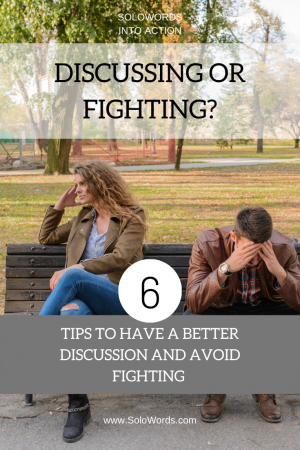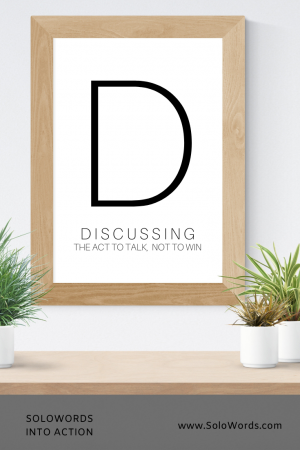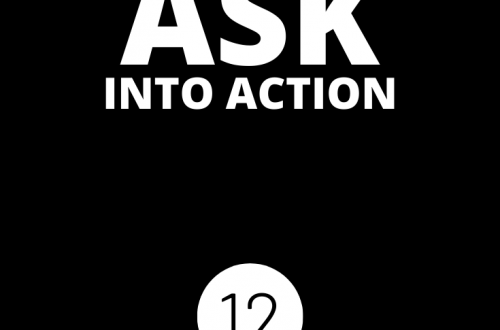
Discussing or Fighting? 6 Tips to have a better discussion and avoid fighting
Discussing or fighting? How many times do we start discussing with someone up to a point we overheat, and the discussion turns into an ugly fight? How often, in a discussion like that, do we verbally attack, blame, and ventilate with anger all our frustration and get the same reaction from the other person? How many times do we feel unfairly treated or misunderstood and react with a verbal assault to the other person?
It is interesting to reflect a little bit about our strategy when having to deal with a situation that will involve a disagreement or discussion. It is even more interesting to reflect on our reactions when we deal with situations like those. What do we do?
Depending on the circumstance or the person with whom we are discussing, we may yell, cry, or say a zillion crosswords. We may remain silent or pretend to ignore what the other person is telling us. Whatever we do, it usually intends to demonstrate to the other person that we are right and the other person is wrong. We want to win the discussion. The problem is that when we discuss to win, we are not discussing, we are fighting.
Let’s start by reviewing the definition of the word “discussion.”
What is "Discussion"?
Lexico.com defines “Discussion” as:
The action or process of talking about something in order to reach a decision or to exchange ideas.
For Cambridge.org “Discussion” is:
The act of talking about something with other people and telling them your ideas or opinions
What is the purpose of a discussion?
As the definition stated, the purpose of a discussion is to exchange ideas. It is the act to communicate our opinions or disagreements to a person or a group of people. It is about letting the other person know the way we think and why or the way we feel and why. The purpose of a discussion is not to win but to exchange.
Whenever we try to impose ourselves over the other side with the only intention to win, then that means that we are not discussing, we are fighting. When we fight, we want to win, which means we want the other person to lose. When we fight, there is physical or verbal aggression involved to defeat the other side.
So before starting a discussion or while we are already at it, let’s stop and ask ourselves: What do we want to do? Do we want to discuss or fight?
There is an excellent video of Jorge Bucay in spanish that talks about this and that I shared with my husband some time ago. From that moment, every time we start arguing, one of us always ask the other: Do you want to discuss or you want to fight with me? Doing this usually makes us laugh and change the tone of our conversation.
6 Tips to have a better discussion and to avoid fighting:
After reading and listening some material about discussion and reflecting about my recent experiences discussing with different people, I came out with 6 tips I think can help us to manage better the way we discuss:
1. Ask ourselves:
- Why do I want to discuss this?
- What do I want to accomplish with the discussion?
- Do I want to discuss, or do I want to fight?
Let’s remember that when we want to discuss with someone about a specific topic, we should not expect a winner or a loser at the end of the discussion. In a discussion, our goal should be to express ourselves and to learn from the other person.
2. Start the discussion by saying something positive about the other person or saying "thank you":
You might be thinking, “Oh sure, I am going to discuss something with someone who I don’t agree with, and I am supposed to start by saying thank you for being so nice.” Yes, That is precisely what we should do. Again, the goal is to discuss, not to fight. Before starting a discussion, let’s find something good about the other person, and let’s make that person know that we appreciate that. By doing this, we make ourselves separate the topic of the discussion from the person we are discussing with.
3. Focus the discussion in facts, opinions, and feelings:
The best way to have a discussion is to focus on facts and personal opinions and feelings. Facts are things that are known or proven to be true. Opinions are entirely personal, and everybody has the right to have theirs even if we don’t agree. Feelings are also personal, and no one can govern over them. What we feel is what we feel, and it should be something safe to express.
On a marriage encounter, I went with my husband, one of the speakers taught us an excellent way to communicate feelings. He said, we should use a scale accompanied by an example to explain better the intensity of our feelings. i.e., We can tell the other person something like this: My strongest feeling right now is frustration. The intensity of my frustration is 7, like going to the beach for vacation and getting rain every day.
4. Be a good listener:
When discussing, we have the right to communicate our point of view, but we also have the duty to listen to the other person’s point of view. This doesn’t mean that we have to agree with the other person. In the end, we all have the right to agree to disagree. The point is that if we want to be listened, we also have to listen.
5. Be open to learning:
Let’s remember that we don’t know everything about everything. Discussions are an excellent way to learn about other people’s points of view and different ideas only if we want to listen. We don’t have the whole truth about anything. We only have our truth, which can be enriched by the truth of someone else if we are open to listening and learn.
6. Get away from typical fight starters:
A discussion should be a safe act to communicate to another person our opinions, points of view, and feelings. However, the way we communicate those things is what makes the difference between discussing or fighting. It is not what we say but how we say it. The line between discussing and fighting is very thin, and we can easily cross it if we don’t pay attention to some starters that are the ones which turn on the fire for a fight:
1. Exaggerating:
Magnifying things to make our point is a way to say I want to fight with you. Exaggerating something that happened or that the other person said or did guarantee a fight because it will be taken as a lie of what happened. When we do this, we make the other person find a way to counter-attack to defend herself.
2. Using the words "always" and "never":
I don’t know if this happens to you, but I get very mad when someone says to me in a discussion, “That happened because you always do…” Always and never are strong words that can hurt feelings because they are radical words that don’t leave an in between option.
3. Demanding or dictating what the other person has to do:
Telling someone, “You have to do this” is different than telling “It will be very helpful if you do this.” We, humans, don’t like to be mandated even though we are somewhat mandated all the time. However, we have to find better ways to ask someone to do something rather than demand it.
4. Playing the psychic:
Typical phrases like “I know what you are thinking” “I know what you are going to say” or “I know why you did it” don’t help in a discussion. The reality is that we don’t know. We can suppose or guess, but we don’t know for sure. Saying this kind of phrases to the other person will probably generate a negative reaction from her or his part.
5. Starting a discussion at the wrong moment and the wrong place:
We have to practice awareness when we enter into a discussion. Read my post about “Awareness is the Key to Everything.” We need to ask ourselves if it is the right moment and the right place. Sometimes we get mad or frustrated and can’t control ourselves. However, starting a discussion without taking into consideration the moment and place can lead to a fight. i.e., Starting a private discussion with someone in front of other people.
6. Diminishing the other person:
We all have our points of view and opinions based on knowledge or experience. When we discuss with someone about a particular topic, it is possible that one party knows more and has more experience than the other party. Exchanging that knowledge and experience is the purpose of a discussion. Diminishing the other party, its knowledge, and experience saying things like: “You don’t know what you are talking about” is a good way to start fighting.
7. Blaming or judging:
Nobody likes to be blamed or judged for anything. It is imperative to be very careful and have proof or evidence if we decide to blame or judge someone.
8. Having bad attitude, behavior, or body language:
Sometimes our bad attitude, behavior, and body language are the spicy ingredients we add to transform any discussion into a fight. They are like weapons we use to attack the other person. When we attack, it means we want to fight, and we should expect a counter-attack. Here are some of the most common weapons we use:
- Rolling our eyes: Let’s remember all the time our parents told us that rolling our eyes was disrespectful. Well, it was and still is. Even as adults, we still do it, and it means we want to fight. The other person can interpret this behavior in different ways: She doesn’t agree with me. She is tired of what I am saying. She doesn’t want to listen. She doesn’t care about what I am saying. All these interpretations the only thing that brings is negative feelings on the other person and probably a reaction.
- Pointing at the person: My husband always says: “Remember that when you point at someone, your other three fingers are pointing at you”
- Ignoring what the other person is trying to say: pretending we are deaf, not listening or paying attention to the person talking to us is also disrespectful and a strong sign of careless.
- Interrupting: not letting the other person express or finish what she or he has to say is a way to try to impose ourselves over others.
- Being aggressive: It could be physical, verbal, or psychological. We use aggression to defend ourselves or to hurt the other person. Hurting other people should never be our intention in a discussion.
- Keeping silence: Some times, it is a good strategy to try to calm things down or to not make things bigger. However, it could also be a weapon that can hurt others and ourselves. A discussion needs two sides that express themselves. If one party decides to be silent, then there is no discussion. Not saying what we want to say and hold all the emotions inside us is like a time bomb that someday will explode. There is a great quote from Simon Sinek that explains this very clearly:
Emotions are like vomit. You can only hold it in for so long before it all comes out…and by that time it’s pretty messy
- Raising our voice: yelling doesn’t guarantee that the other person will listen to us and understand our point. It only ensures the possibility that the other person yells back to us or respond in another aggressive way.
Conclusion:
Discussion is a fundamental part of our everyday lives. We discuss with our spouses, children, parents, siblings, relatives, friends, boss, employees, co-workers, and even with people we don’t know. Knowing the difference between discussing and fighting and choosing discussion over fighting can make us have better relationships.
When having a discussion we can get very passionate, excited, and sometimes even tense when we don’t agree with the other person. The important thing we need to understand is that in a discussion nobody has to win and nobody should hurt the other person. Let’s ask ourselves every time we enter into a discussion what we really want to do, discuss, or fight?
Here are my two questions for you:
- When was your last discussion?
- Did you discuss or fight?
Easy to download, high resolution image to print at home or favorite local or online print shop in any of the following sizes: 5 x 7, 8 x 10, 11 x 14, 16 x 20 and 18 x 24. To download, click the green bottom bellow.



You May Also Like

Take the risk and ask: 12 things worth asking
November 13, 2019
Declutter: Don’t keep it if you don’t need it. Instead, give it.
October 16, 2019